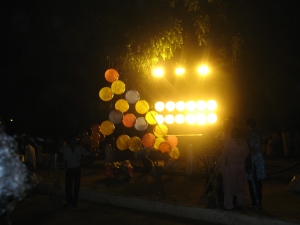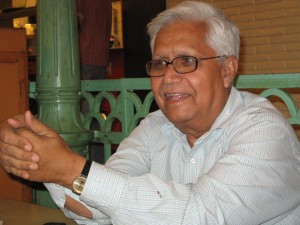HILARIOUS!
Posted on: October 3, 2008
Kashmiri
One Kashmiri = carpet salesman.
Two Kashmiris = carpet factory.
Three Kashmiris = terrorist outfit.
Four Kashmiris = shoot-at-sight order.
Tamil-Brahmin
One Tam-Brahm = priest at the Vardarajaperumal temple.
Two Tam-Brahms = Maths tuition class.
Three Tam-Brahms = Queue outside the U.S consulate at 4 a.m.
Four Tam-Brahms = Thyagaraja music festival in Santa Clara
Mallu
One Mallu = coconut stall.
Two Mallus = a boat race.
Three Mallus = Gulf job racket.
Four Mallus = oil slick.
Gujju
One Gujju = share-broker in a Bombay train.
Two Gujjus = rummy game in a Bombay train.
Three Gujjus = Bombay ‘s noisiest restaurant.
Four Gujjus = stock market scam.
Andhraite
One Andhraite = chili farmer.
Two Andhraites = software company in New Jersey ..
Three Andhraites = Naxalite outfit.
Four Andhraites = song-and-dance number in a Telugu movie.
Mumbaikar
One Mumbaikar = footpath vada-pav stall.
Two Mumbaikars= film studio.
Three Mumbaikars = slum.
Four Mumbaikars = The number of people standing on your foot in the
train at rush hour.
Sindhi
One Sindhi = currency racket.
Two Sindhis = papad factory.
Three Sindhis = duplicate goods shop in Ulhasnagar …
Four Sindhis = Hong Kong Retail Traders Association. .
Marwari
One Marwari = The neighbourhood foodstuffs adulterator.
Two Marwaris = 50% of Calcutta
Three Marwaris = Finish off all Gujaratis & Sindhis.
Four Marwaris = Threaten the Jews as a community.
Haryanvi
One Haryanavi = tube light.
Two Haryanavis = agriculture.
Three Haryannavis = Lathi squad.
Four Haryanavis = actually just one was enough.
Last but the best
Kannadiga
One kannadiga = devegowda
Two kannadigas = devegowda with his son Kumarswamy
Three kannadigas = rivals of devegowda family
Four Kannadigas = total no of kannadigas in bengaluru
Bihari
One Bihari = Laloo Prasad Yadav .
Two Biharis = booth-capturing squad.
Three Biharis = train capture.
Four Biharis = caste riots
Five Biharis = entire literate population of Patna …
Bengali
One Bengali = poet.
Two Bengalis = a film society.
Three Bengalis = political party.
Four Bengalis = two political parties.
More than four Bengalis = Countrywide agitation to bring Ganguli into Team.
Punjabi
One Punjabi =100 kg hulk named Pinky.
Two Punjabis = Pinky with his bigger brother Twinky.
Three Punjabis = assault on the McAloo Tikkis at the local McDonalds
Four Punjabis = combined IQ equal to one.
Sorry, no Coorgs or Parsis……too small to make an impact..start breeding…..
Splendid, indeed
Posted on: October 2, 2008
A Thousand Splendid Suns
Khaled Hosseini
 When I got this book as a birthday present, I was skeptical. Though I loved his previous one, The Kite Runner, I wasn’t sure whether another book on war-torn Afghanistan would be arresting. After all, this one was again on the same country, the same cityscape. There was another reason for my reluctance to read another book on Afghanistan: news fatigue. As a journalist, I am bombarded with news and photographs from Afghanistan almost everyday.
When I got this book as a birthday present, I was skeptical. Though I loved his previous one, The Kite Runner, I wasn’t sure whether another book on war-torn Afghanistan would be arresting. After all, this one was again on the same country, the same cityscape. There was another reason for my reluctance to read another book on Afghanistan: news fatigue. As a journalist, I am bombarded with news and photographs from Afghanistan almost everyday.
Then one fine day after finishing Pallavi Aiyar’s book on China, I decided to give it a go. I read the first five pages and gave up. Started again. Stopped. This went on for a while. Then one fine day, I just couldn’t keep it down. I raced through the pages, read it while going to office, at coffee shops and restaurants. (Sometimes in office too. I hope the Ed is not reading this!)
And, this is what I think makes the book so special: its capacity to draw in even an uninterested reader.
The story revolves mainly around two women and their lives and and how their lives coalesced, collided and merged again by the twist of fate and politics. They were born in two different cities (Herat and Kabul), led very different lives till they were teenagers —- one a ‘harami’ born to a maid servant and the other born to middle-class, educated parents —- and then were married to the same man. While all this was happening, Kabul — the Kabul of Saeb-e-Tabrizi and other Farsi poets — was transformed into the Kabul of Taliban and then again the sanitized Kabul of Hamid Karzai.
The author has beautifully fleshed out the characters and their emotions, and yet everything unfolds in a restrained, understated way. The most beautiful aspect is how the author handles the relationship between Mariam and Laila — two women with more than a decade difference in age but married to the same man.
The author could have easily messed up the plot, overplayed the tension between the two protagonists. But not Hosseini; he has given each their time and space in the story. Not even for once anything seemed excess or forced.
Mehrauli Archaeological Park
Posted on: September 19, 2008
One of the few reasons to stay put in Delhi. An amazing walk, must do this again this winter.
Random shots
Posted on: September 19, 2008
High art is rubbish
Posted on: September 19, 2008
- In: india
- Leave a Comment
 These days we dread to walk out of our office building. No, we are not afraid of becoming terror targets; rather two innocuous blue dustbins are the source of our unease. As a precautionary measure after the blasts, the keepers of our civic aesthetics — the municipal corporations — have decided to keep dustbins upside down. This ultra low-tech security measure was prompted by the fact that the terrorists had planted the bombs in dustbins.
These days we dread to walk out of our office building. No, we are not afraid of becoming terror targets; rather two innocuous blue dustbins are the source of our unease. As a precautionary measure after the blasts, the keepers of our civic aesthetics — the municipal corporations — have decided to keep dustbins upside down. This ultra low-tech security measure was prompted by the fact that the terrorists had planted the bombs in dustbins.
Dinesh Kumar Mishra is a busy man these days. He has been following the twists and turns of the Kosi river for more than 20 years. Now he has published <Kosi: Trapped! Between the Devil and Deep Waters> and journalists are making a beeline to scribble down as much information on the floods raging in north Bihar from Mishra as possible. “It is a coincidence that the book was released at a time when there’s so much focus on Kosi and the devastation,” says Mishra, an IIT Kharagpur alumni.
So is he going back to Ground Zero soon? “Yes. But this upheaval is hardly new. It’s a yearly tragedy. It’s the national media that has suddenly developed some interest in this,” he says, quickly adding that he hopes that this spotlight will ignite a debate on what he has been saying for decades now: embankments along Kosi have repeatedly led to such crises and no dam at Barahkshetra in Nepal will solve this recurring problem. About 380 villages in Bihar are trapped between the two embankments of Kosi and around a million people are subject to its onslaughts every year. This time, it just happens that we sat up and noticed.
“A dam will not solve the problem because it won’t control the silt-laden waters. Moreover, there’s a catchment below this proposed dam that gets good showers and the water of this area will threaten downstream areas of Kosi,” argues Mishra, popularly known as ‘Guruji’. Incidentally, the first proposal to build a dam at Barahkshetra was made in 1937. Offices in Nepal, however, were opened only in 2004 for feasibility studies.
But despite such devastation wrought by the river every year, Mishra is against calling Kosi Bihar’s ‘River of Sorrow’. “The British called it so because when the river was in spate, revenue collection used to be a problem. But even they never thought of jacketing it. The local people continue to adore Kosi,” he points out. British administrator Charles Elliot, he says, once said that if there is anything that could be said about the behaviour of Kosi, it is uncertainty. “But our engineers sought a quick-fix solution initiated by their political masters,” he laments.
Many would think that Mishra comes from Bihar and that recurrent floods compelled him to take up ‘the cause’. He laughs heartily at that notion. Mishra points out that he’s from the “Abu Salem town”, Azamgarh in Uttar Pradesh. It was just a coincidence that got him interested in the Kosi. “A close friend of mine, Vikas, once asked me to go to flood-hit Saharsa to compile a report. Reluctantly, I agreed. I reached the place and was completely taken aback by the amount of water I saw. I sent Vikas a telegram asking for relief material. I was sent again after six months to do a larger report on rivers of north Bihar. To do that, I had to go to the Calcutta National Library and read newspapers from the 1940s. And soon I discovered that everything that we had been told about the floods were lies, lies, lies. After that, there was no turning back,” he recalls. His repetition of the word ‘lies’ leave one’s ears ringing.
So how effective has the state government’s disaster management plans been? “I met the Bihar Disaster Management Minister Nitish Mishra on August 5 when Kosi had started cutting the spurs,” says Dinesh. “Mishra was enumerating all that the state government had done. But the present situation tells a different story. In fact, even his own village house has been flooded.” He points out how the government has changed the name of departments. “‘Irrigation’ has become ‘Water Resources’, ‘Relief and Rehab’ has become ‘Disaster Management’. But the character of these departments has remained the same.”
His years of ground-level experience and intensive research are captured in the book in a clear-headad manner. Starting from the scriptures, it includes legends of Kosi, folklores, history of attempts to tackle floods in India, the efforts and 100-year-old debates to tame the river, the decision-making and construction process, scams and their outcomes and aftermath. It is also littered with voices of people — living and dead — who have been affected by the Kosi and by administrative attempts to ‘fix’ the Kosi problem.
A nugget: “The Kosi is regarded as a virgin river because it is carefree, it does not bother about bondages and carves a new path for itself whenever it likes….. As the legend goes women fed up with the vagaries of the river put vermillion powder in the river to threaten it with marriage and it is said that the river runs away from the scene.” One of the most disturbing parts of the book is the testimonies of people who are at the receiving end of our flood protection measures and irrigation schemes. “The recurring floods have led to huge migration. The kharif is gone and the rabi will go too. The next employment in Bihar will be March 2009. There will be mass and huge migration; earlier it used to be seasonal but now the scope and push will be much higher,” he says.
“The living conditions within the embankments, where the residents are deprived of all the civic amenities that are treated as basic civic amenities are a slur on any civilised society,” he writes in the book. Can this loss be reversed? “The biggest loss is that the river has lost its basic character,” he writes. “It is supposed to drain its catchment. But in this case the Kosi is spreading the waters back into its catchment, leaving large areas almost permanently waterlogged. ….This loss is irreversible and cannot be translated into money value.”
Things will probably only change when floods become an election issue. But in Bihar, unfortunately — and surprisingly — that has not happened yet. “In Bihar, it is caste and party that rule the manifestos,” he adds ruefully.
Before the meeting, one expected to meet someone angry and agitated at the turn of the events brought about by callous and faulty planning. But Mishra, unlike his muse, the Kosi, turns out to be calm, collected and logical – something that is reflected amply in the book he has written.
In the end, you get what you deserve. The only issue is how swift the retribution is. Till Wednesday, two of Delhi’s top businessmen — Gopal and Sushil Ansal — were lucky on the second count. They did all that they could — moved all levers of power — to roam free while the family members of the Uphaar victims struggled to come to terms with their painful memories of that fateful day. But the Supreme Court order on Wednesday changed all that.
The apex court cancelled the bail of Sushil and Gopal Ansal, owners of Uphaar cinema where 59 cinegoers were killed in a fire tragedy in 1997, for tampering with judicial records. In a hard-hitting statement, the Bench said that tampering with records is a crime worse than “murder or dacoity”. The real estate tycoons surrendered on Thursday and were sent to judicial custody for 14 days. Now, the case will go back to being heard in the High Court where the builders have challenged the guilty verdict against them.
The court order is no doubt a huge morale-booster for the Association of Victims of the Uphaar Tragedy who for years have been struggling with their own memories as well as against the accused; and also for all those who still have some trust left in our slow and creaking judicial process. The importance of the order can be understood better if we look at what the Ansals have been accused of destroying — evidence that proves they were involved in the day-to-day running of the Uphaar cinema. By doing so, they hoped to distance themselves from the fact that they were involved in the management of the theatre. More surprisingly, crucial case documents were filed in court but went missing almost five years ago. Do we need any more evidence of the collusion between officials and the builders?
As the court order shows, their attempts have come to naught. The muck was always there, but this order has made sure that the stains will be difficult to wash away. The order will also be a handy precedent for cases that are in the pipeline but have been faltering because evidence has been tampered with.
Sab Maya Hai
Posted on: July 26, 2008
Sab Maya Hai
Yesterday, I was chatting with a friend on the rise and rise of Mayawati. S, a senior MNC executive, was at the Dubai airport, waiting for his connecting flight to Jeddah, while I was nicely ensconced somewhere in Connaught Place, New Delhi.

pic courtsey: http://www.siliconeer.com
Here is what he had to say about M:
14:56: How could people project Mayawati as PM!!! We should now vote for a majority government…
14:57: regional parties can exist at the regional level but at the national level they have to support one big party. She was Kanshi Ram’s mistress, right?
A second later, he admitted that the last sentence was not politically correct.
14:59: there is a huge theory on women as leaders….. as women leaders sense power they become far more corrupt and power hungry than men because they need to fight a glass ceiling battle…. so they need to prove themselves… of course this theory is made by men …
Cut to an editorial meeting at a national daily. A senior journalist said she would leave the profession if M becomes PM. “Her horrible pink silk suits and those diamonds…oh my God…”.
I guess we sneer at M because she is not one of us, the Fab India kurta-wearing types. Nevertheless, I am amazed at these reactions. I wonder whether we can dismiss an idea whose time has come; I think we are refusing to accept certain changes that are sweeping through India, the other India.
Last month, I was at a small Dalit village in Uttar Pradesh. During a discussion on politics, a young man told me that M victory has given them the courage to speak up against police atrocities and corrupt government officials. I guess this is where M’s power comes from.
A colleague (her hometown is Bareilly, UP) says that M is ‘far better’ than MY (Mulayam Singh Yadav). Why, I ask her. Her explanation is fairly simple: “See, I agree M takes bribes but at least she ensures that some of it goes to the people, even to non-Dalits. But during their regime, MY and cronies would pocket 100 per cent. Only some Yadav pockets would get something.”
I was never very much interested in UP politics but I must admit that the rise of M has changed all that. Whether I like or not, I am convinced she is the woman to watch out for. No wonder, therefore, I am reading Ajoy Bose’s new book: Behenji, A biography of Mayawati.
Here comes the sun
Posted on: July 24, 2008
Last week, residents of Hyderabad were in for a shock when the state government announced that there would be no electricity for two to six hours everyday. As for the industrial areas, there would be a one-day ‘electricity holiday’ every week. The reason? A shortfall of 1,000 MW. Is there any way out? Click here to know more:










